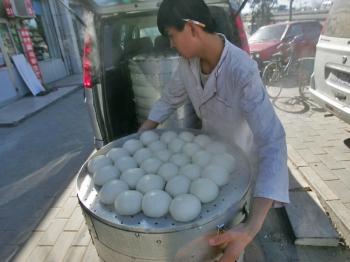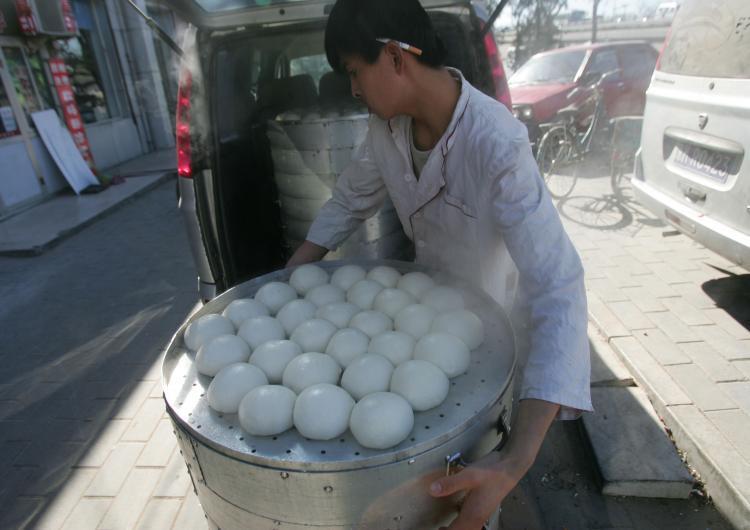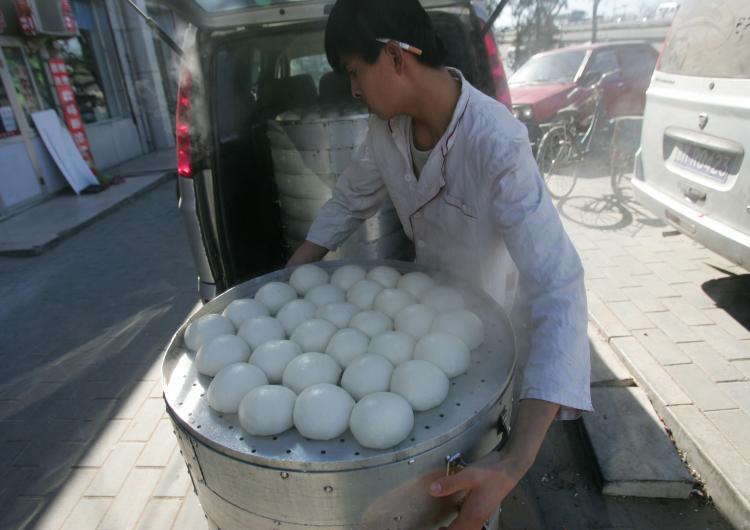Steamed buns are hot sellers in China, they are sold by the tens of thousands and eaten like bread in our country, but they have just become the latest item added to the long list of tainted foods there.
Two days after officials shut down the Shanghai Shenglu Food Company on April 13, and ordered a massive recall of chemical-laden buns, another bun factory in a southern city of China was found to produce tens of thousands of “corn buns” without corn but with loads of artificial color and flavoring chemicals instead.
The bun production site, located on Ganzhong Road in Wenzhou City, Zhejiang Province, was a very old, dirty, and primitive make-shift facility according to an April 17 Youth Times report.
Steamers were placed on the ground in a tent outside the building, next to piles of coal and charcoal. There was mud all over the ground and mold on the walls.
Five bottles of Tartrazine, also called lemon yellow 60, sweet corn flavor, golden corn flavor, three bags of saccharin sodium, and dry yeast were sitting on the workplace counter. But not a grain of corn was seen anywhere, the Youth Times said.
A female worker at the site said the lemon yellow, corn flavor, and wheat flour were mixed together to make “corn” buns. White buns are made without the artificial color, she said. Saccharin sodium and other additives were added to increase sweetness and flavor. “As far as how much to add in, it depends on the look and feel,” the worker said.
The fake corn bun production site was discovered on April 15. Based on their business records, they had sold nearly 200,000 buns from March 22 to April 14, 10,000 of them to nearby universities.
Days earlier, it was discovered that buns made by Shenglu Foods Co., Ltd. Shanghai Branch, and sold in many Shanghai supermarkets, contained various illegal additives. Expired buns were allegedly also reprocessed and turned into “new” buns, according to Shanghai’s Eastday.com
Five suspects have been detained for their involvement in the production and sale during 2011 of 330,000 buns containing illegal additives and artificial coloring, officials said. A massive bun recall has been ordered, and Shenglu’s license has been revoked.
The company passed industry and business standards tests and obtained their hygiene license from 2000 to 2009, Daily Economic News said.
In July 2007 allegations surfaced of a Beijing snack vendor stuffing steamed buns with flavored cardboard. Although officials at the time called it a hoax and detained the undercover reporter, Reuters said there was mounting pressure from abroad over food and product safety scandals in China.
Many Chinese also expressed skepticism towards official reports, which tends to be sanguine and almost never reflects poorly on the ruling communist party, Reuters said.
Read the original Chinese article.
Two days after officials shut down the Shanghai Shenglu Food Company on April 13, and ordered a massive recall of chemical-laden buns, another bun factory in a southern city of China was found to produce tens of thousands of “corn buns” without corn but with loads of artificial color and flavoring chemicals instead.
The bun production site, located on Ganzhong Road in Wenzhou City, Zhejiang Province, was a very old, dirty, and primitive make-shift facility according to an April 17 Youth Times report.
Steamers were placed on the ground in a tent outside the building, next to piles of coal and charcoal. There was mud all over the ground and mold on the walls.
Five bottles of Tartrazine, also called lemon yellow 60, sweet corn flavor, golden corn flavor, three bags of saccharin sodium, and dry yeast were sitting on the workplace counter. But not a grain of corn was seen anywhere, the Youth Times said.
A female worker at the site said the lemon yellow, corn flavor, and wheat flour were mixed together to make “corn” buns. White buns are made without the artificial color, she said. Saccharin sodium and other additives were added to increase sweetness and flavor. “As far as how much to add in, it depends on the look and feel,” the worker said.
The fake corn bun production site was discovered on April 15. Based on their business records, they had sold nearly 200,000 buns from March 22 to April 14, 10,000 of them to nearby universities.
Days earlier, it was discovered that buns made by Shenglu Foods Co., Ltd. Shanghai Branch, and sold in many Shanghai supermarkets, contained various illegal additives. Expired buns were allegedly also reprocessed and turned into “new” buns, according to Shanghai’s Eastday.com
Five suspects have been detained for their involvement in the production and sale during 2011 of 330,000 buns containing illegal additives and artificial coloring, officials said. A massive bun recall has been ordered, and Shenglu’s license has been revoked.
The company passed industry and business standards tests and obtained their hygiene license from 2000 to 2009, Daily Economic News said.
In July 2007 allegations surfaced of a Beijing snack vendor stuffing steamed buns with flavored cardboard. Although officials at the time called it a hoax and detained the undercover reporter, Reuters said there was mounting pressure from abroad over food and product safety scandals in China.
Many Chinese also expressed skepticism towards official reports, which tends to be sanguine and almost never reflects poorly on the ruling communist party, Reuters said.
Read the original Chinese article.







Friends Read Free